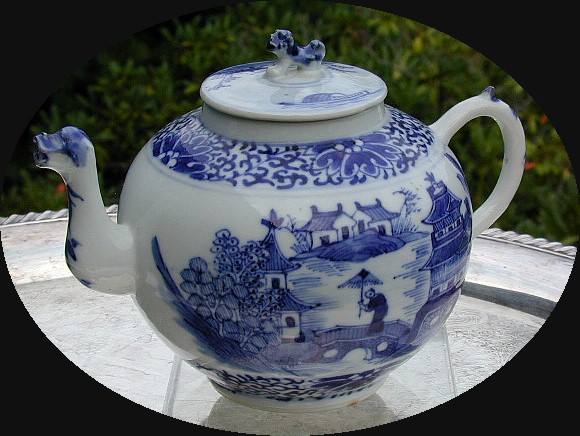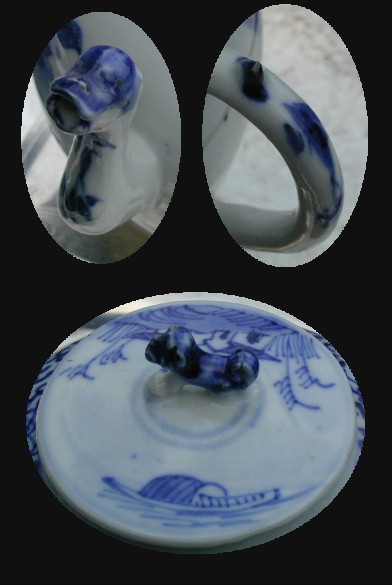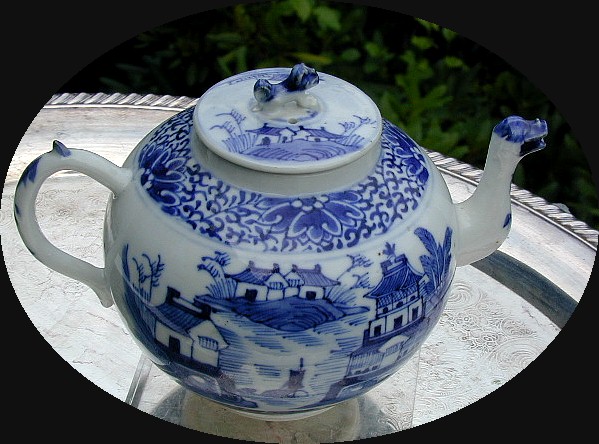| | |
.
| |  ID
GALLERIES
ID
GALLERIESFeedback rating: (435) |  auctions auctions
. | EMAIL questions
|
.
| | 
.
|
.
|
.
|
.
|
.
|
.
|
.
|
.
|
.
|
.
|
.
|
.
| |

| 
| |||||
|
A very fine blue & white Chinese export teapot with a cute lion or foo dog head spout and a little lion or foo dog finial. The spout has relief detail for the mouth, nose and ears. Water garden scene on one side with a little man holding an umbrella to cross the bridge in front of a pagoda; another water scene on the other side with a sampan sailing across. The cover has a conforning theme. The handle has a thorn tip. Excellent deep & rich cobalt blue, very fine brushwork. The biscuit is very fine and white, much better than what is normally used for export china ware. (Although very fine export porcelain was used sometimes for export, especially those custom made services made for the East India Company or Jardines, for example. We see it here most often in high quality Fitzhugh.) 3 strainer holes at the bottom of the spout. Circa 1800.
About 5"H x 7"W spout to handle. A couple of grit spots on the footrim; no chips cracks or hairlines. Very good condition almost new. This is a rare antique gem in blue & white. Unique and not likely to find another. | 
| |||||
Price: $880.00 SOLD
|
NOTE : This example is a predecessor to Nanking, of a quality which nanking export tried to achieve, an earlier product before the terminology "nanking" was formalized. We think of Nanking as having a water scene with figure(s), and with particular borders. It is also considered to have finer detail than canton, which came into being earlier.
| A historical note may be useful here. In the days of the China trade, export porcelain lined the ballast area of the returning ships. At the bottom were placed the cantons and rose medallions, which were usually company cargo. The private trade porcelain of the captain, first mate or supercargo were usually of better quality, often much finer. (The company, say East India, maximized quantity. The private trader, say captain, maximized value due to limited assigned space.) The private trade was often for complete services (sometimes running to thousands of pieces per service) of custom order and of some value. Such cargo was placed on top of the other porcelain. Before the late 1700's, there were no standardized borders and scenes such as canton, nanking & fitzhugh. The demand for large sets of matching services lead to some standardization, beginning with canton for the American trade and Fitzhugh for the English. Nanking followed later as a result of demand for better quality service than canton.
The best of the Chinese Ch'ing export porcelain were from the early period roughly between 1700-1821. There was in incredible variety of colors, materials, designs, forms and whimsey. Most of these were from the private trade for the wealthy patrons. This teapot is from the end of this period (1800-1820), and the main design is in fact what became nanking. However, the borders have a distinct Chinese flavor of the earlier era, as do the lion finial and spout. The porcelain and glaze are from the fine Ching de Cheng fine kilns, which were out of operation for a period of time during the reign of Tao-kuang (1821-1850).
| A nanking collector may well consider this exceptional teapot as an early example to which nanking design aspires. Others may consider it as an early step in the development of the style known as nanking. In any case it is a very fine Chinese export blue/white porcelain with a well defined point in time. |